The BYD C6 is a fully electric midibus manufactured by the Chinese company BYD, which specialises in electric vehicles and new energy solutions.
Four BYD C6 midibuses entered revenue service with SMRT Buses progressively from 17 October 2019, deployed on Bus Service 825, the only public bus service in Singapore operating using shorter-length buses. As part of the Sembawang-Yishun Bus Package, all four buses were transferred from SMRT Buses to Tower Transit in October 2021.
The bus design incorporates large-capacity Lithium-Iron-Phosphate batteries which allow the bus to travel more than 200km on a single charge, under urban road conditions. Private operators ShareTransport and Grab first trialled the BYD C6 back in 2018.
This article focuses on the 4 units of BYD C6 buses (PC7991M, PC8561P, PC8656A, PC8669M) that are configured as public buses and operated on public bus routes.
Introduction
In early 2019, BYD (Singapore) Pte. Ltd. took delivery of four BYD C6 buses configured as public buses for revenue service. They were leased to SMRT Buses, and commenced revenue service on Bus Service 825 on 17 October 2019.
These buses were bodied by Gemilang Coachworks of Malaysia, using the BYD D6R chassis, then delivered in LTA’s Lush Green livery. Delivery documents attached to the bus reflected the chassis model (BYD D6R) when delivered; these vehicles were later registered as BYD C6 vehicles.
Originally commencing revenue with 2 buses in October 2019, all 4 buses entered revenue service by late-December 2019.
- PC7991M – Registered in March 2019
- PC8656A – Registered in October 2019
- PC8561P & PC8669M – Registered in November 2019
Technical Specifications
| Basic Technical Specifications | |
| Electric motors | BYD-3425TZ-XS-A Permanent Magnet Synchronous Motor Continuous power of 150 kW Maximum power/torque of 180 kW/1500 Nm Regenerative braking capabilities + Front and rear disc brakes |
| Battery | BYD Iron-Phosphate battery 135kWh-capacity Iron-phosphate batteries, ~4 hours full charge >200 km range under normal conditions |
| Bodywork | Gemilang Coachworks bodywork ‘EcoRange’ aluminium bus body |
| EDS | Mobitec MobiLED Compact (Front) Mobitec MobiLED (Rear) |
| PIDS | LECIP LED Passenger Information Display System with interior speakers |
| ADAS | TNTS Surround View Camera System (installed by Tower Transit under Sembawang–Yishun Bus Package) |
| Passenger Capacity | 19 Seated Passengers + 5 Standing Passengers 1 Wheelchair Bay |
| Additional Features | Akdülger city plus seats Unladen weight: 7340 kg Caroil RPI 300 Cassette Lift (Wheelchair lift) |
These buses are owned by BYD (Singapore) Pte. Ltd. and leased to Tower Transit. The lease was transferred from SMRT Buses to Tower Transit in October 2021.
Interior:
The bus combines forward-facing seats on the left side with side-facing seats on the right side and a central aisle running the length of the bus. All seats also have hand grips to provide commuters with additional support while moving within the bus. Emergency hammers are mounted on pillars in-between windows.
The BYD C6 features an emergency door located at the rear offside of the bus. Formerly a mandated safety feature on buses, these have largely been replaced with emergency hammers as a means of emergency egress, with the former Volvo B10M-60 (Mark IV) (Walter Alexander Strider) buses being the last public buses to feature them.
In addition, the BYD C6 is wheelchair-accessible via a wheelchair lift located at the passenger entrance/exit door. A single wheelchair bay is opposite the entrance/exit door, with a passenger-in-wheelchair (PIW) alighting bell mounted along the handlebar. The aisle-facing foldable handlebar can be manually deployed and stowed depending on the needs of the passenger.
The backrest contains a foldable seat that doubles as a rear-facing seat for one person. This seat does not contribute to the licensed carrying capacity of the bus.
A single plug door serves as the entrance and exit for passengers. With two steps leading up to the bus, handlebars are installed to guide passengers around the steps, so that that passengers do not inadvertently skip a step when alighting from the bus, which might result in a fall.
Both handlebars can be moved to make way for wheelchair boarding and alighting. The lower handlebar retracts into the side of the bus, while the upper handlebar can be unlocked from the floor, pivoted away from the entrance, and re-secured.
The wheelchair lift is stowed underneath the steps, and a wired remote controller (used for lift operation) is mounted next to the entrance.
Two card readers are mounted on the bus as a means of redundancy in the event of failure, with both configured for entry and exit operation. The coinbox is located next to the door rather than being next to the driver’s cab, which differs from all other public buses. Finally, the fire extinguisher and first aid kit are secured to wall brackets beside the door. as opposed to having their own dedicated storage compartment like other public buses.
The driver’s cab is accessed via a conventional hinged door on the offside, and separated from the passenger cabin by a single stowable handlebar. Most bus controls, such as light and door switches, air-conditioning and Electronic Display Signage (EDS) controller, are installed to the left of the driver.
Gallery – Exterior
Page 2: More Photos
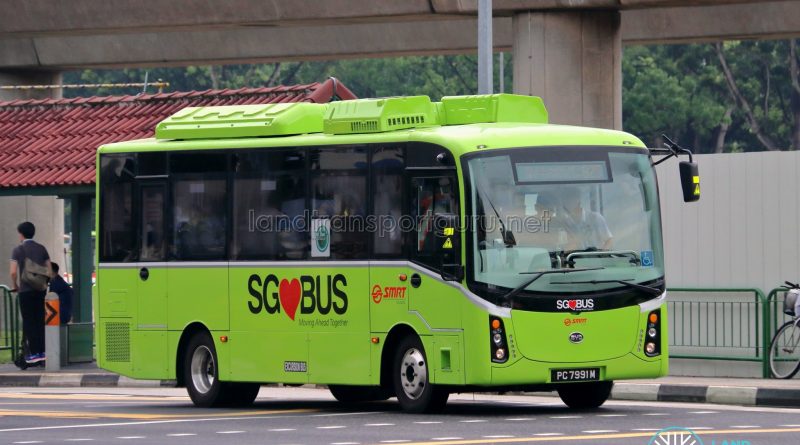
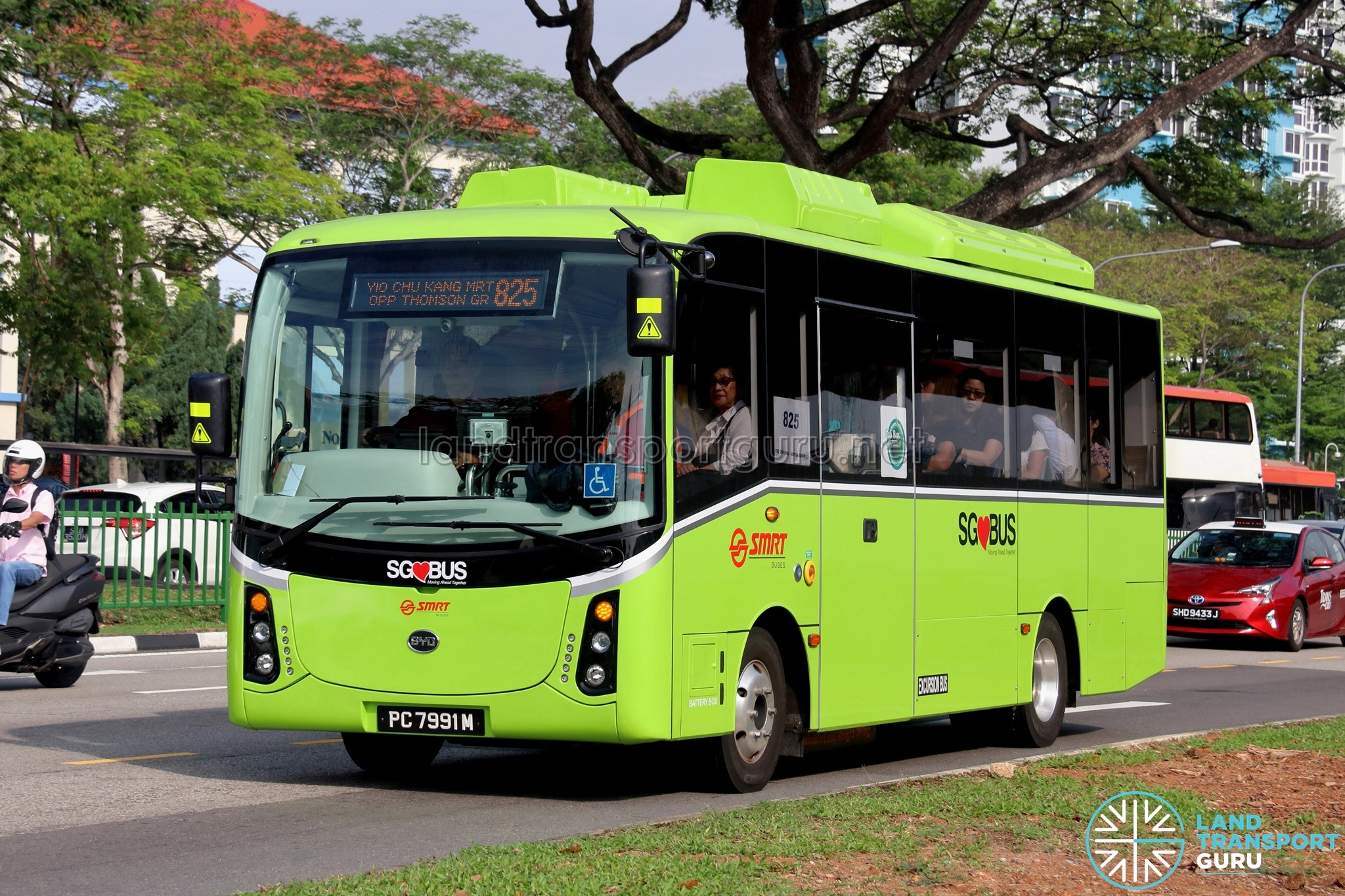

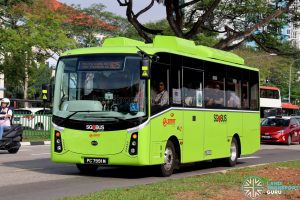
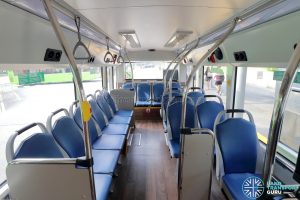
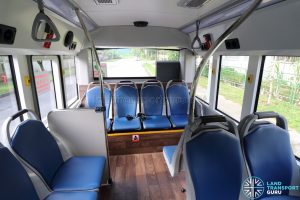

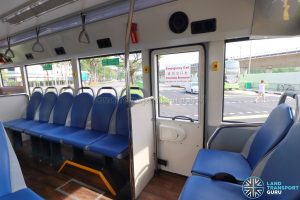

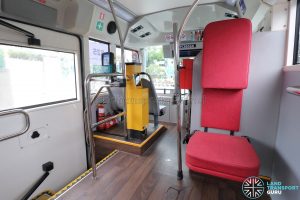
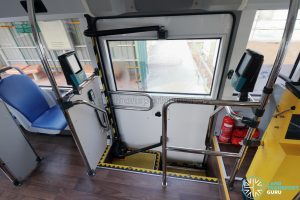
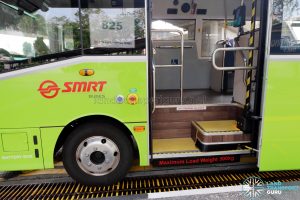
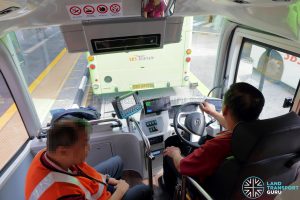
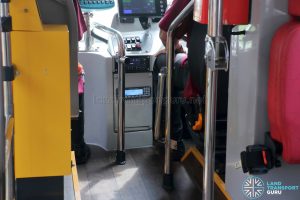
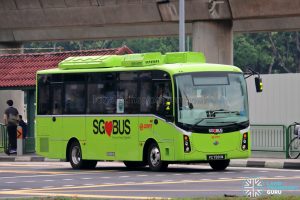
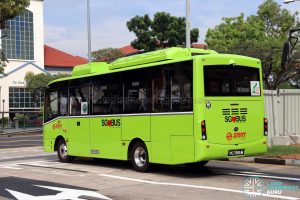
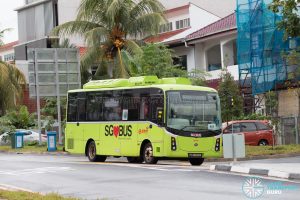
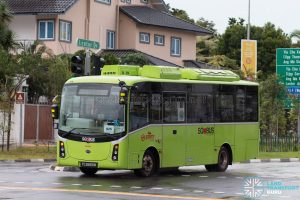
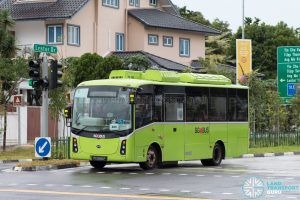
Look at the interior photos of this bus, look at the emergency exit one. You will see the Volvo B8L in the background!!
Yeah, It is true. But I cant see what service its operating on
SMRT should deploy this type of buses on Feeder Services during off peak hours in Yishun & Woodlands
when there are not many passengers instead of using double decker buses
I recommend SDs to be placed there, unless the frequency (of the people) is less than 19 per bus (this includes peak hours).